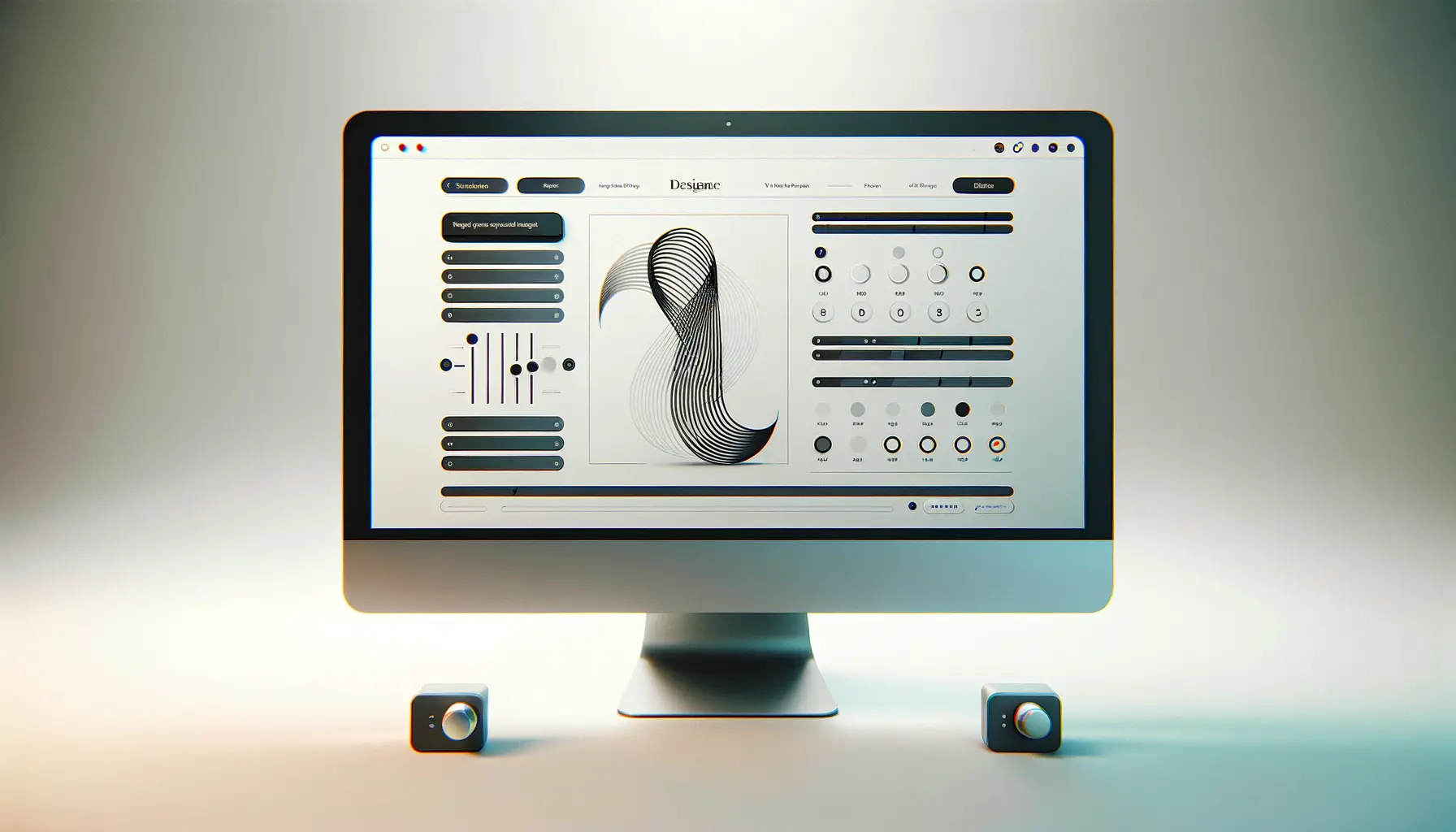Variable fonts are revolutionizing the way we think about web typography.
Unlike traditional static fonts that require separate files for each style and weight, variable fonts condense multiple variations into a single, efficient file.
This breakthrough in font technology offers unprecedented flexibility and control over typography on the web, enabling designers to fine-tune the appearance of text with ease.
The concept of variable fonts is not just a technical advancement; it’s a tool that empowers creativity and innovation in web design.
At the heart of variable fonts lies the ability to adjust characteristics such as weight, width, slant, and optical size dynamically through CSS.
This adaptability makes it possible to create more responsive and engaging designs that respond to user interaction and environmental conditions.
The benefits of using variable fonts in web design are manifold, including improved performance, reduced load times, and enhanced aesthetic coherence across different screen sizes and devices.
Let’s delve into the world of variable fonts and explore how they can be leveraged for flexible web design.
- Understanding Variable Fonts
- Implementing Variable Fonts in Web Design
- Responsive Typography with Variable Fonts
- Designing for Readability and Accessibility
- Optimizing Performance with Variable Fonts
- Creative Typography with Variable Fonts
- Future Trends in Variable Fonts
- Embracing the Future with Variable Fonts
- Variable Fonts FAQ
Understanding Variable Fonts
What Are Variable Fonts?
Variable fonts are a type of OpenType font that includes multiple variations of a typeface within a single file.
This innovative format allows for the adjustment of font characteristics along predefined axes such as weight, width, and slant.
By harnessing the power of variable fonts, designers can access a wide range of styles without the need for multiple font files, streamlining the design process and improving website performance.
The concept of variable fonts was introduced to tackle the limitations of traditional fonts on the web.
With the increasing demand for responsive and dynamic web content, variable fonts offer a solution that caters to the diverse needs of modern web design.
By enabling real-time customization of font attributes, variable fonts pave the way for more versatile and adaptable typography.
Benefits of Using Variable Fonts
One of the key advantages of variable fonts is their ability to enhance web performance.
By consolidating multiple font variations into a single file, variable fonts significantly reduce the amount of data that needs to be transferred over the network.
This reduction in file size leads to faster page load times, a crucial factor in user experience and SEO rankings.
Additionally, variable fonts minimize the need for font substitution, ensuring a more consistent visual experience across different devices and screen resolutions.
Another benefit of variable fonts is their flexibility in design.
Designers can adjust font characteristics on the fly, allowing for dynamic typographic expressions that adapt to user interactions or screen orientations.
This level of control opens up new possibilities for creative web design, from subtle adjustments that enhance readability to dramatic transformations that engage and captivate users.
Variable fonts represent a significant leap forward in web typography, offering both performance enhancements and creative opportunities. By understanding and utilizing variable fonts, designers can create more responsive, expressive, and efficient web designs.
Implementing Variable Fonts in Web Design
Integrating variable fonts into web design requires a blend of technical understanding and creative experimentation.
The process involves selecting the right variable font, defining it in your CSS, and then manipulating its axes to achieve the desired typographic effect.
This section guides you through the steps to effectively implement variable fonts in your web projects, ensuring both aesthetic appeal and performance efficiency.
Firstly, choosing a variable font that aligns with your design goals is crucial.
Consider the font’s available axes of variation and how they can be utilized to enhance your web design.
Once a suitable font is selected, the next step is to incorporate it into your website using CSS.
- Font Selection: Explore and select a variable font that complements your design. Pay attention to the range of variations it offers, such as weight, width, and slant.
- CSS Integration: Use the
@font-facerule to define the variable font in your CSS, specifying the font family and the source of the font file. - Manipulating Font Axes: Adjust the font’s appearance by modifying its axes through the
font-variation-settingsproperty. This allows for dynamic control over the font’s weight, width, and other characteristics.
Best Practices for Using Variable Fonts
While variable fonts offer a wide range of possibilities, following best practices ensures that their implementation enhances both the design and performance of your website:
- Optimize for Performance: Although variable fonts reduce file sizes, it’s important to only load the variations you need. Use the
font-weight,font-stretch, andfont-styleproperties to specify the required range of variations. - Enhance User Experience: Leverage the flexibility of variable fonts to improve readability and user engagement. Adjust font weight and size based on user interaction or screen size to create a more dynamic and accessible interface.
- Test Across Browsers: Ensure compatibility and consistent rendering across different browsers and devices. Test your implementation thoroughly to identify and address any issues.
By adhering to these best practices, you can effectively harness the power of variable fonts to create visually appealing and performant web designs.
The ability to fine-tune typography in real-time opens up new avenues for creative expression and user engagement on the web.
Remember, the key to successfully integrating variable fonts into your web design lies in understanding their capabilities and experimenting with their variations to find the best fit for your project.
Responsive Typography with Variable Fonts
Responsive typography is a cornerstone of modern web design, ensuring that text is legible and aesthetically pleasing across a wide range of devices and screen sizes.
Variable fonts elevate responsive design by offering unparalleled flexibility in adjusting typography to suit different display environments.
This section explores how variable fonts can be leveraged to achieve responsive typography that adapts to the user’s device, enhancing readability and user experience.
Utilizing variable fonts for responsive typography involves dynamically adjusting font properties based on screen size, resolution, and user preferences.
This adaptability not only improves the visual harmony of your website but also contributes to a more personalized user experience.
Here’s how to implement responsive typography with variable fonts:
- Viewport Width (vw) Units: Use vw units to scale font size relative to the viewport width. This ensures that your typography scales up or down smoothly as the browser window is resized.
- Media Queries: Combine variable fonts with CSS media queries to adjust font properties for different screen sizes. This allows for precise control over typography in specific display scenarios.
- Custom Properties: Utilize CSS custom properties (variables) to create scalable and maintainable typographic systems. Define font sizes, weights, and other properties as variables, and adjust them based on media queries or user interactions.
Adapting Typography to User Preferences
Beyond adjusting to screen sizes, variable fonts can also adapt to user preferences, such as dark mode or reduced motion settings.
This level of customization enhances accessibility and user satisfaction.
For instance, you can increase font weight in dark mode to offset the reduced contrast, or adjust the font’s optical size for better readability at different resolutions.
Implementing responsive typography with variable fonts not only improves the visual appeal of your website but also its usability and accessibility.
By thoughtfully adjusting font properties in response to the user’s environment and preferences, you can create a more engaging and inclusive web experience.
Consider the broader implications of responsive typography in your design strategy. Beyond mere aesthetics, responsive typography facilitated by variable fonts can significantly enhance the usability and accessibility of your web content.
Designing for Readability and Accessibility
Readability and accessibility are fundamental to creating inclusive web experiences that cater to a diverse audience.
Variable fonts play a crucial role in this by providing the tools necessary to tailor typography to various user needs and preferences.
This section delves into strategies for leveraging variable fonts to enhance the readability and accessibility of web content, ensuring that it is approachable and understandable for all users.
Effective use of variable fonts can significantly improve text legibility, making web content more accessible to individuals with visual impairments or reading difficulties.
By adjusting font characteristics such as weight, width, and optical size, designers can optimize text for readability across different devices and viewing conditions.
- Contrast and Weight: Increase font weight to improve contrast against backgrounds, especially for users with low vision. Variable fonts allow for fine-tuning of weight without loading additional font files.
- Dynamic Text Sizing: Use variable fonts to adjust text size dynamically based on user preferences or device settings. This is particularly beneficial for users who require larger text to read comfortably.
- Optical Sizing: Take advantage of the optical sizing feature in variable fonts to enhance text legibility at small sizes. Optical sizing adjusts the character shape for better readability at various sizes.
Adaptive Typography for Enhanced Accessibility
Adaptive typography goes beyond basic readability, tailoring the reading experience to individual user needs.
Variable fonts facilitate this by enabling real-time adjustments to typography based on user-selected settings or automatic detection of user preferences.
For instance, a website can offer a control panel that allows users to adjust font weight, size, and spacing according to their comfort level.
This empowers users, giving them control over their reading experience and making web content more accessible.
Additionally, integrating variable fonts with assistive technologies can further enhance accessibility, ensuring that all users, regardless of their abilities, can access and engage with web content effectively.
True accessibility in web design means going beyond compliance with standards to actively engaging with users’ diverse needs. Variable fonts are a powerful tool in this endeavor, offering unprecedented flexibility to adapt typography to enhance readability and accessibility.
Optimizing Performance with Variable Fonts
The performance implications of using variable fonts in web design are profound, offering a significant advantage over traditional font files.
By consolidating multiple font styles and weights into a single file, variable fonts can drastically reduce the number of HTTP requests and the overall size of font resources.
This part of the article explores strategies for optimizing web performance through the judicious use of variable fonts, ensuring that your site remains fast and responsive.
Performance optimization with variable fonts involves more than just reducing file sizes; it’s about leveraging the flexibility of variable fonts to deliver a tailored, efficient user experience.
Here are key considerations and techniques for optimizing performance while maintaining design flexibility:
- Selective Loading: Although variable fonts contain multiple variations, it’s crucial to load only the axes and ranges you need. Use the
font-variation-settingsproperty wisely to avoid unnecessary bloat. - Subsetting: Reduce the file size of your variable fonts by subsetting, which involves removing unused characters and glyphs from the font file. This can significantly decrease the amount of data transferred.
- Efficient Use of Variations: Be strategic about the variations you employ. Excessive use of different font weights or styles can lead to performance issues, even with variable fonts. Aim for a balance between design diversity and simplicity.
Impact on Web Performance Metrics
The use of variable fonts directly influences key web performance metrics, such as First Contentful Paint (FCP) and Largest Contentful Paint (LCP).
By reducing the amount of font data needed to render a page, variable fonts can help improve these metrics, contributing to a faster, more responsive user experience.
Moreover, the reduced complexity of font management simplifies the web development process, allowing for more focus on other performance optimization areas.
Implementing variable fonts with performance in mind requires a thoughtful approach to typography and design.
By prioritizing efficiency and user experience, designers and developers can harness the power of variable fonts to create fast, engaging websites that stand out in the digital landscape.
Featured Info: Embracing variable fonts is a step towards modern, efficient web design. Their impact on performance is a testament to the evolving nature of web technologies, pushing the boundaries of what’s possible in responsive, user-centric design.
Creative Typography with Variable Fonts
The advent of variable fonts has opened up new horizons for creative typography in web design.
Beyond the technical benefits of improved performance and flexibility, variable fonts offer an expansive canvas for artistic expression.
This section explores the creative possibilities that variable fonts unlock, allowing designers to craft unique, dynamic typographic experiences that engage and captivate users.
With variable fonts, designers are no longer constrained by the limitations of static fonts.
The ability to adjust font properties in real-time enables the creation of interactive, responsive text that can react to user inputs, environmental conditions, or even scroll positions.
This dynamic interplay between text and user creates a more immersive web experience, blurring the lines between content and design.
- Interactive Typography: Implement interactive elements where text changes in response to user actions, such as hover, click, or scroll. This can include changes in weight, width, or other properties, adding a layer of engagement to your site.
- Animated Text Effects: Use variable fonts to create animated text effects that transition smoothly between states or styles. This can be particularly effective for hero sections, headings, or call-to-action buttons.
- Contextual Adaptation: Design text that adapts to context, such as altering its appearance based on the time of day, weather conditions, or user preferences. This level of personalization enhances the user experience and reinforces the site’s thematic elements.
Exploring New Design Frontiers
The creative application of variable fonts challenges traditional notions of web typography, encouraging designers to explore new design frontiers.
By experimenting with the vast range of typographic variations available, designers can discover novel ways to convey mood, tone, and brand identity through text alone.
This exploration not only enriches the visual language of the web but also deepens the user’s emotional connection to the content.
Embracing the creative potential of variable fonts requires a willingness to experiment and a deep understanding of typographic principles.
However, the rewards are substantial, offering a means to differentiate your designs in a crowded digital landscape.
As variable fonts continue to gain popularity, their role in shaping the future of web typography is undeniable, promising a more expressive, engaging, and personalized web.
False Information: The misconception that variable fonts are merely a technical enhancement underestimates their transformative impact on web design. In reality, variable fonts are a powerful tool for creative expression, enabling designers to push the boundaries of typography in exciting new directions.
Future Trends in Variable Fonts
The evolution of variable fonts is a testament to the ongoing innovation in web typography.
As we look to the future, it’s clear that variable fonts will continue to shape the landscape of web design, driven by advancements in technology and changing user expectations.
This section explores potential future trends in variable fonts, highlighting how they may further revolutionize the way we think about and interact with typography on the web.
As variable fonts mature, we can anticipate developments that extend their functionality and application.
These advancements will not only enhance the technical capabilities of variable fonts but also expand their creative and expressive potential.
The future of variable fonts is poised to bring even greater flexibility, performance, and innovation to web typography.
- Increased Adoption and Support: As awareness of variable fonts grows, we can expect broader adoption across web platforms and design tools. This will likely be accompanied by improved support in browsers, making variable fonts more accessible to designers and developers.
- Integration with Emerging Technologies: Variable fonts may integrate more deeply with emerging web technologies such as augmented reality (AR), virtual reality (VR), and voice interfaces. This could open up new avenues for typographic expression that are currently unexplored.
- Advancements in Font Interpolation: Future developments in font interpolation could allow for more nuanced and complex variations within variable fonts. This might include the ability to interpolate not just between weight and width, but also more abstract qualities like mood or tone.
Enhancing User Experience and Accessibility
Looking ahead, the role of variable fonts in enhancing user experience and accessibility is likely to become even more significant.
Innovations in variable font technology could lead to more adaptive and responsive typography that better serves the needs of all users, including those with disabilities.
For example, fonts could automatically adjust for optimal readability based on ambient light conditions or the user’s vision preferences.
The potential for variable fonts to contribute to more personalized and inclusive web experiences is immense.
As designers and developers continue to explore and push the boundaries of what variable fonts can do, we can expect to see typography that is not only more beautiful and engaging but also more empathetic and responsive to the diverse needs of users around the globe.
Your Idea: The future of variable fonts is not just about technological innovation; it’s about reimagining the possibilities of typography to create more dynamic, inclusive, and expressive web experiences. As we look forward, the potential for variable fonts to transform web design is limited only by our creativity and willingness to explore new frontiers.
Embracing the Future with Variable Fonts
The journey through the capabilities, benefits, and creative potential of variable fonts underscores their transformative impact on web design.
As we’ve explored, variable fonts offer a unique blend of flexibility, performance, and artistic freedom, enabling designers to craft responsive, accessible, and visually compelling web experiences.
The evolution of variable fonts is not merely a technical advancement; it represents a paradigm shift in how we approach typography in the digital age.
The Path Forward
As variable fonts continue to gain traction, their integration into web design practices is expected to deepen.
The future trends in variable fonts, including increased adoption, integration with emerging technologies, and advancements in font interpolation, promise to further enhance the dynamism and expressiveness of web typography.
These developments will not only elevate the aesthetic quality of web design but also its functional and inclusive aspects, making content more accessible and enjoyable for all users.
- Broader adoption and improved browser support will make variable fonts more accessible to designers and developers, encouraging their use in a wider range of projects.
- The integration of variable fonts with AR, VR, and voice interfaces will open new frontiers in typographic design, offering unprecedented opportunities for creative expression.
- Advancements in font interpolation technology will allow for even more nuanced and complex typographic variations, enabling designers to convey mood, tone, and brand identity with greater precision.
Conclusion
In conclusion, the advent of variable fonts marks a significant milestone in web typography, offering a versatile toolset for enhancing web design.
By embracing variable fonts, designers and developers can create more responsive, accessible, and engaging web experiences that cater to the diverse needs of users.
The future of variable fonts is bright, filled with possibilities for innovation and creativity.
As we move forward, it’s clear that variable fonts will play a pivotal role in shaping the future of web design, making it more dynamic, inclusive, and expressive.
Quality web design is key for a great website! Check out our service page to partner with an expert web design agency.
Variable Fonts FAQ
Explore commonly asked questions about variable fonts and discover how they can transform your web design projects.
Variable fonts are a typeface innovation allowing customization of style, weight, and width within a single font file, enhancing web design flexibility.
By consolidating multiple font variations into one file, variable fonts reduce HTTP requests and load times, improving overall website speed.
Yes, variable fonts enable designers to adjust typography for optimal readability and accessibility, catering to diverse user needs.
Most modern browsers support variable fonts, but it’s important to check compatibility and provide fallbacks for older versions.
Use the @font-face rule to define the variable font and the font-variation-settings property to adjust its axes.
Unlike static fonts, variable fonts offer a range of styles and weights within a single file, allowing dynamic typographic adjustments.
Absolutely, variable fonts are ideal for responsive design, enabling typography that adapts seamlessly to different screen sizes and resolutions.
Variable fonts unlock creative possibilities for dynamic, interactive typography, making web content more engaging and visually appealing.












